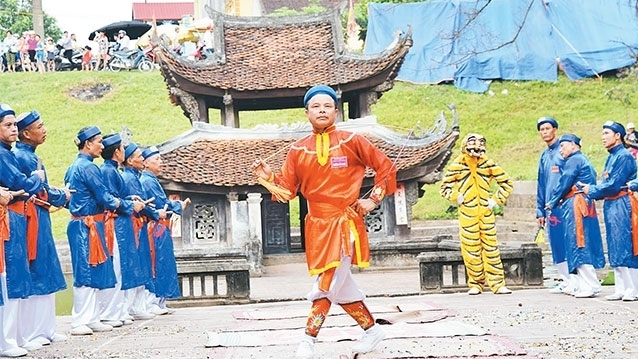At the beginning of this year, the Trieu Khuc village festival and the craft of making “com” (young sticky rice flakes) in Me Tri ward, Nam Tu Liem district, were added on the Ministry of Culture, Sports and Tourism’s list of national intangible cultural heritages.
With the acknowledgement, Hanoi tops the country in terms of the number of national intangible cultural heritages, with 18 in total. The heritages stand out from nearly 1,800 of their kind in the capital city in different categories of festivals, folklore knowledge, oral traditions, performing arts and social practices.
The 18 recognised heritages include 11 festivals and others in such forms as rituals and traditional practices (seated tug of war in Long Bien district; Ai Lao singing and dancing of Hoi Xa hamlet, Long Bien district; the worshipping of Saint Tan Vien in Ba Vi district), folk arts (‘ca tru’ or ceremonial singing), and traditional crafts (the making of ‘com’), among others.
According to Dr Pham Thi Lan Anh, Head of the Heritage Management Office under the Hanoi’s Department of Culture and Sports, the city has many other heritages which meet the criteria for national status and the 18 honoured heritages were selected thanks to their unique values, and great efforts made by the community in preservation.
After the recognition was granted, the functional agencies from the Department of Culture and Sports have coordinated with the local authorities in designing measures to safeguard and promote the heritages’ value. Resultantly, some of the heritages have been promoted as tourist products which have considerably benefited local residents.
Tremendous efforts have been made to keep the value of the heritages intact which can be seen through the preservation of Ai Lao folk singing and dancing. According to folk legends, the art form is associated with the legend of Saint Giong, a legendary Vietnamese hero who fought against the northern invaders.
It was said that after having fought triumphantly the enemy, Saint Giong rode an iron horse to Mount Soc and flew away, leaving her mother in deep sadness. Then, the King ordered the young herders who had tethered their buffaloes in Hoi Xa Village to follow Saint Giong into battle, to sing and dance to soothe his mother, which is how the ai lao song and dance was born.
As time passes, many lyrics of the singing have been forgotten, requiring the Department of Culture and Sports to work closely with scientists and the local authorities to seek historical documents and people’s memories in order to restore the original version of the art form.
For ca tru – a genre of ceremonial signing which was named in UNESCO’s List of Intangible Cultural Heritage in Need of Urgent Safeguarding, the city’s authorities have taken actions to support ca tru singing art troupes, and record and digitalise lyrics and knowledge of the art form.
Hanoi now has many actively operating ca tru singing clubs and art troupes with hundreds of practitioners, such as Thang Long, Lo Khe and Thai Ha. At the National Ca Tru Singing Festival 2018 held n Ha Tinh province, the team from Hanoi won seven individual prizes and ranked first in the medal tally.
Attention has also been given to better safeguard and draw public interest in traditional festivals and rituals. The worshipping of Saint Tan Vien in Ba Vi district, the Saint Giong Festival in Soc Son and Gia Lam district, and the Hai Ba Trung Temple Festival in Me Linh district have attracted tens of thousands of pilgrims every year.
However, intangible cultural heritages have strong connection with the community and practitioners, making them changeable as time goes by. Therefore, according to Hanoi’s Department of Culture and Sports, greater efforts are required to keep the heritage’s value intact and make them more welcoming to visitors.




